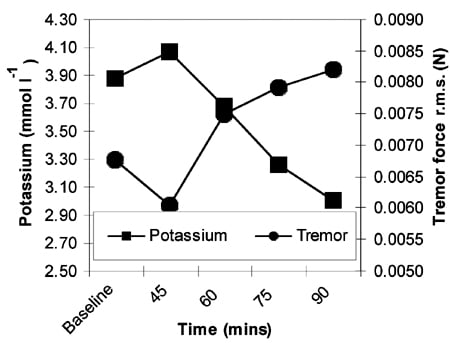Adrenergic agonists increase tremor size. The effect has been attributed to changes in the contractile properties of muscle rather than changes in the neural control system (Marsden et al. 1967). Here we use an isometric method of recording tremor to show that an adrenergic drug reduces stability and that this is associated with a clear change in the contractile characteristics of the muscle. Also, stability appears to correlate directly with the plasma potassium concentration.
We recorded tremor in an isometric force maintenance task. Subjects used the left first dorsal interosseus muscle to maintain a static force equal to 20 % of the maximal voluntary force. Tremor was recorded under control conditions and following infusion of the β2 agonist drug, terbutaline (Bricanyl) at 8 µg kg-1 h-1 by a cannula inserted into the left ante-cubital vein for a period of 45 min. A cannula was inserted in to the right ante-cubital fossa for venous blood sampling. The subject relaxed for a period of 45 min during which three control measurements of tremor were made and venous blood samples were taken.
Blood samples were processed and stored at -80 °C and were subsequently analysed for plasma K+ (indirect ion-specific electrode). In these experiments there were a number of infusions of different drugs and placebos with each subject being infused on five occasions. The subject was blind to the agent being infused.
Figure 1 shows the relationship between tremor size (r.m.s force fluctuation) and plasma concentration of K+. Repeated measures analysis showed that terbutaline infusion produced a significant decrease in postural stability (P < 0.05). Tremor size and plasma K+ vary reciprocally. This result is similar to that of Fowler & Lipworth (2001) who suggested that tremor measurement or plasma K+ could equivalently be used as a surrogate for the pharmokinetic profile of inhaled salbutamol.
Our conclusion is that terbutaline increases tremor size by changing the contractile characteristics of muscle. The effect is traditionally attributed to β2 adrenoreceptors in skeletal muscle. We alternatively suggest that the mechanism may be linked to interstitial K+ concentration, which directly affects the activation of skeletal muscle by decreasing the conductivity of the T tubules. We tentatively suggest that other factors, which influence tremor size, may involve this link.

